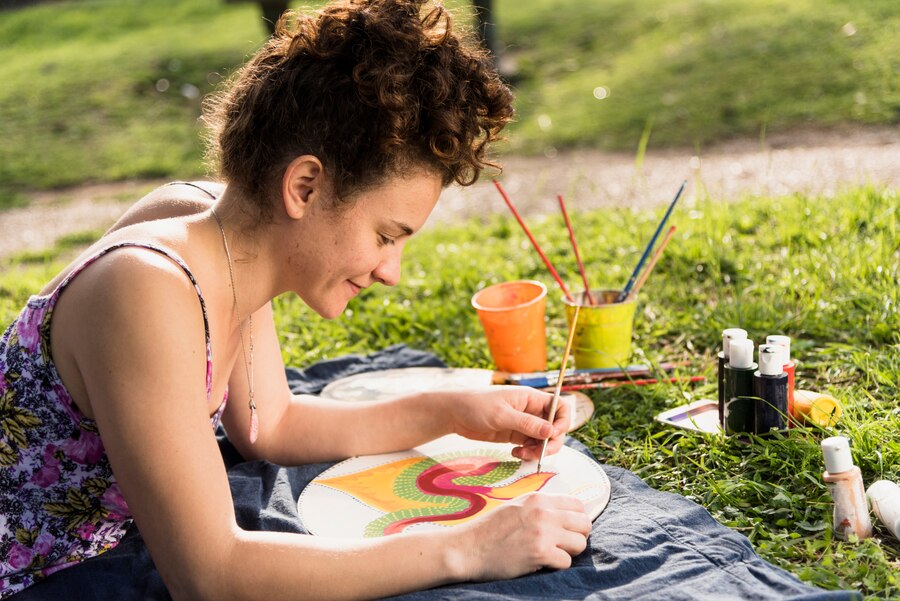
Getting Started with Gouache Landscapes
If you’ve ever admired beautiful landscape paintings and wondered how to create your own, gouache might be the perfect medium to explore. This versatile paint combines the best qualities of watercolor and acrylic, making it ideal for beginners. Moreover, gouache dries with a matte finish that perfectly captures the subtle textures found in nature.
First, let’s gather the essential supplies for your gouache landscape journey. You’ll need artist-quality gouache paints in primary colors, a few brushes of different sizes, watercolor paper, a palette, and a water container. Additionally, keep paper towels handy for blotting and cleaning brushes.
Understanding Gouache Properties for Landscape Work
Gouache offers unique characteristics that make it especially suitable for landscape painting. For instance, its opacity allows you to layer light colors over dark ones, unlike watercolor. Furthermore, gouache remains water-soluble even after drying, which gives you flexibility while working.
The paint dries quickly, so you can build layers efficiently. However, this quality also means you must work somewhat decisively. In addition, gouache creates vibrant, matte colors that photograph beautifully – perfect for sharing your landscape creations online!
Essential Techniques for Beginner Landscape Artists
When starting your gouache landscape journey, mastering a few fundamental techniques will set you up for success. Initially, practice creating smooth washes for skies and water. Then, experiment with dry brush techniques for texturing elements like mountains or trees.
Learning to blend colors while they’re still wet helps create smooth gradients for sunsets or fog effects. Similarly, understanding how to layer paint will give your landscapes depth and dimension. Meanwhile, practicing simple compositions will build your confidence before tackling more complex scenes.
Painting Different Landscape Elements with Gouache
Skies and Clouds
The sky often forms the backdrop of landscape paintings. To create realistic skies, start with a light blue wash. Subsequently, add clouds using a lifting technique with a damp brush. Alternatively, you can layer white gouache for clouds after your sky dries.
Mountains and Hills
For distant mountains, mix blue-grays and apply them with a light touch. Then, add darker values to create shadows that suggest dimension. Meanwhile, for closer hills, incorporate more detail and stronger color contrasts to bring them forward in your composition.
Trees and Vegetation
When painting trees, begin with larger shapes and gradually add detail. Furthermore, vary your greens by mixing yellows, blues, and even reds to create natural-looking foliage. In addition, use dry brush techniques to suggest texture in leaves and branches.
Water Features
Reflections make water features compelling in landscapes. First, paint the water surface with horizontal strokes. After that, add reflections of surrounding elements using vertical brushstrokes. Finally, incorporate small white highlights to suggest movement and light.
Common Challenges and Solutions for Beginners
Many beginners struggle with gouache drying too quickly. However, you can overcome this by preparing all your colors before starting and using a spray bottle to mist your palette occasionally. Additionally, working in smaller sections helps manage the fast-drying nature of gouache.
Another frequent challenge is achieving smooth gradients. Nevertheless, with practice and by keeping your paint at the right consistency—not too thick or thin—you’ll soon master this skill. Meanwhile, if you make mistakes, remember that gouache is forgiving; you can paint over errors once the layer dries.
Creating Your First Complete Landscape
Ready to create your first landscape? Begin by selecting a simple reference photo with clear light direction. Then, sketch the basic composition lightly on your paper. After that, block in the largest shapes with mid-tones, working from background to foreground.
Once your base layers are dry, add details and refine your painting. Subsequently, evaluate your work from a distance to check the overall composition. Finally, add highlights and final touches to complete your landscape masterpiece.
Taking Your Gouache Landscapes to the Next Level
As your skills improve, experiment with different papers and color palettes. Moreover, try painting the same scene at different times of day to understand how light affects landscape elements. Additionally, challenge yourself with various weather conditions like rain, fog, or snow in your compositions.
Joining online communities or local art groups can provide valuable feedback and inspiration. Furthermore, studying the work of landscape masters will enhance your understanding of composition and color theory. Meanwhile, regular practice remains the key to continuous improvement.
Remember, every artist’s journey is unique. Therefore, enjoy the process of discovering your own style while using this versatile medium to capture the beauty of landscapes around you.
